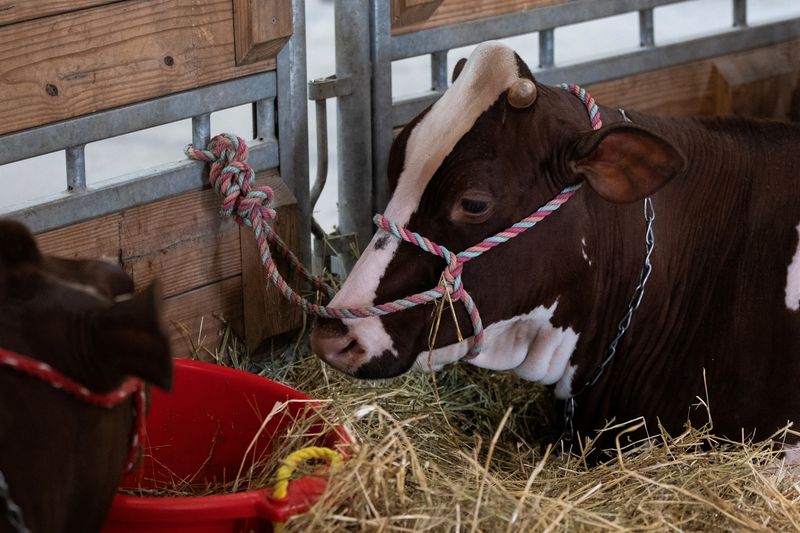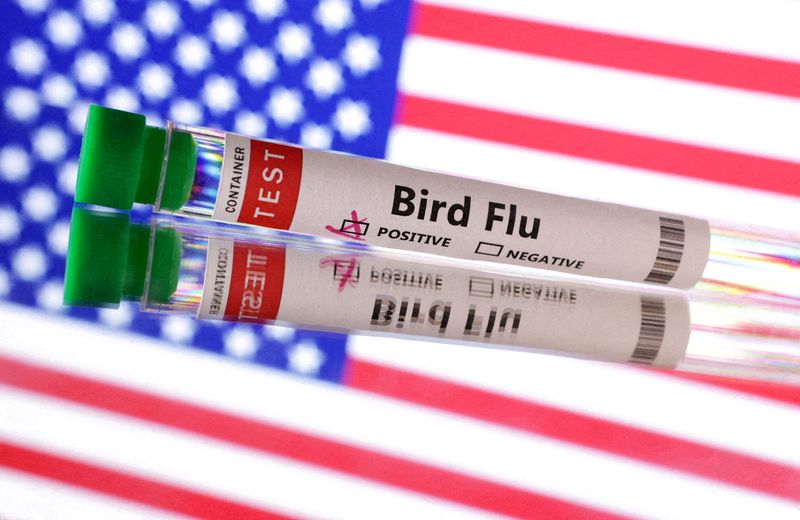By Leah Douglas and Tom Polansek
(Reuters) - The U.S. Department of Agriculture weakened an emergency order last spring designed to prevent the spread of bird flu among the nation's dairy cattle after pushback from state and industry officials, according to state and federal records seen by Reuters.
The communications, which have not previously been reported, show how the early federal response to the U.S. bird flu outbreak was shaped in part by industry interests reluctant to cooperate with burdensome regulation, and potentially contributed to transmission of the disease across state lines.
The USDA's order, released in April after bird flu cases were discovered in cows in eight states, requires milk-producing dairy cattle moving across state lines to secure a negative bird flu test no more than seven days prior to travel. It also allows non-producing cattle headed to slaughter to cross state lines without a veterinarian's clean bill of health.
The USDA had initially contemplated more stringent requirements, including a three-day time frame for testing, but responded to industry feedback urging leniency before releasing the order, according to documents contained in the records request.
Relaxing the order may have enabled more spread of the virus, two veterinarians and one dairy industry representative told Reuters. They noted logistical constraints to testing animals in the shorter window.
When the agency issued the April 24 order, 33 herds had tested positive. The outbreak has since ballooned to more than 330 herds across 14 states and human cases in 17 dairy workers.
"Any changes or clarifications to the Federal Order have been made with the objective of protecting animal and public health by following scientific best practices, using the best available data, and ensuring the appropriate balance between compliance and feasibility for producers," a USDA spokesperson said in an email.
The agency has conducted more than 16,000 pre-movement tests and is supporting an investigation in California into whether improper cattle movement introduced the virus to the state, the spokesperson said.
The rapid spread of bird flu among dairy herds and infections of 27 people this year have alarmed some public health experts, who say the USDA is not responding aggressively enough.
The order remains the only national requirement to curb transmission of the virus.
MEMOS AND MEETINGS
USDA chief veterinarian Rosemary Sifford met with the Livestock Marketing Association to discuss the planned federal order on the morning of April 24, according to a memo the industry group sent to USDA officials released in a public records request.
"The 72-hour pre-movement time frame we have heard is being contemplated is simply not accomplishable," wrote LMA's vice president of government and industry affairs Chelsea Good, suggesting a 7- to 14-day testing window instead.
The farm agency did not include a time frame for testing in the initial order or supplemental information issued on April 25. A guidance document released on April 26 allowed dairies seven days for testing.
In an ideal world, testing would happen within 24 hours, said Keith Poulsen, a veterinarian and director of the Wisconsin Veterinary Diagnostic Laboratory. The rural location of dairy farms makes it difficult to transport samples to a lab, he added.
During the same April week, state animal health officials told USDA it should allow states to agree on alternative documentation in lieu of a veterinary bill of health for non-lactating dairy cows moving across state lines to slaughter, the records show. Older dairy cattle are often processed into ground beef.
In the April 26 guidance document, USDA said states would be able to accept alternative documentation, which can include such basic information as addresses of cattle owners and shippers.
Requiring veterinary documents is too expensive for dairies operating on slim margins, said Bob Seiler, president of the Central Equity Milk Cooperative in Kansas. He said he has not been required to provide alternative documentation when sending non-lactating cows to slaughter.
Side-stepping the veterinary sign-off could have allowed for further spread of the virus, said Gail Hansen, a former Kansas state veterinarian.
"The chances of something slipping through the cracks is a lot bigger," she said.
A shortage of rural veterinarians could make it difficult for farmers to get their herds inspected before every shipment, Poulsen said.
The USDA spokesperson said cows moving to slaughter are considered a lower risk for spreading bird flu and that alternative documentation allows for traceability if there are infections.
'NO UPSIDE TO TEST'
California is examining how the virus entered the state, including whether imports of cows met legal requirements, the state agriculture department said. More than 130 herds and 13 dairy workers in the top dairy state have been infected since the end of August.
Even before the federal order, the farm sector was leaning on state officials to fend off calls for restrictions on cattle movement, according to the records obtained by Reuters.
In a March 26 email, the CEO of the Kansas Farm Bureau, Terry Holdren, asked Kansas Agriculture Secretary Mike Beam and Justin Smith, the state's animal health officer, if they could apply "any leverage or pressure" to keep Nebraska accepting cattle, after hearing Nebraska may turn cattle away.
Nebraska on April 1 began requiring a permit for female breeding dairy cows coming from other states.

Farmers in some cases have shunned testing of cows.
"There's been no upside to a dairy producer to report and test," said Rick Naerebout, CEO of the Idaho Dairymen's Association.
